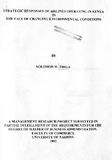| dc.description.abstract | In business, firms must utilize strategy - be it explicit or implicit, in order to
survive especially, in an ever-changing environment. In today's global village, the
levels and intensity of competition faced by firms can be extremely high. This
research endeavored to establish the strategic responses being utilized in the
airline industry, which has of late become both increasingly global and has faced
rather turbulent environmental conditions.
While the study set out to conduct a census survey of all the regional and
international airlines represented at the country's leading airport, it had to make do
with a sample due to reasons of accessibility. The researcher collected data
through the administration of a structured questionnaire. 8 out of the targeted
population of 16 airlines participated in the study. The study established that
airlines had been undergoing a period of considerable environmental turbulence-
"
indeed, even the initial target population of 18 airlines decreased to the above
mentioned 16 during the course of data collection due to the exit of two airlines.
The turbulence level in the environment in which airlines operate increased to an
unpredictable level due to the surprising events of 11th September 2001. Apart
from the unfortunate incidents on the above day, airlines operating in Kenya had
been experiencing challenging environmental conditions.
Vlll
The study documented the following changes in the environment in which airlines
operate:
1. Globalization of world markets
2. World-wide economic recession
3. Increased competition due to strategic alliances/partnerships
4. Increased operating costs
Further, from the research study, it became evident that the major challenge facing
airlines was not only how to maintain or improve profitability but even how to
survive in an increasingly unattractive industry. Strategic responses by airlines
were therefore geared toward keeping costs low to increase profit margins and
improvement of product/service offering to increase airline attractiveness hence
turnover.
The study documented the following key responses by airlines to changes in
"
environmental conditions:
1. Expansion of networks through alliances
2. Shelving of unprofitable routes
3. Productivity improvements to cut costs
4. Continual improvement of services
The above environmental changes and responses are some of the study's key
findings. Further, as airlines respond to environmental changes, there has been an
ix
increased tendency toward the use of collaborative rather than competitive
strategy; with one collaborating block of airlines competing against another. | en |

